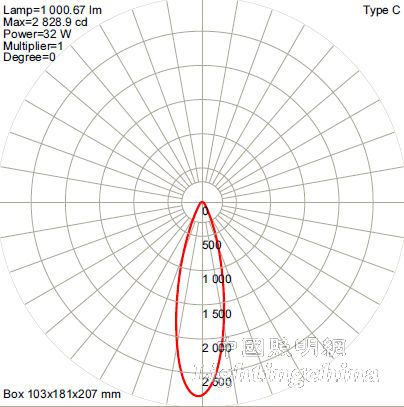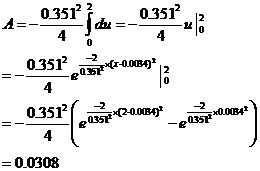Illumination comparison of fixed distances has become one of the simple and effective methods to compare the brightness of two lamps. Then, for lamps with slightly different angles, comparing the axial illumination does not explain the difference in lumen output. For example, a 15 degree luminaire, an axial 100Lx, a 20 degree luminaire with an axial 90Lx, which one has a high lumen output? For the average owner and designer, it is not easy to send a check, and the cost of testing a IES is also Not low, time is long.
In fact, collecting a little more illuminance data, we can get the lumens of the luminaire like the integrating sphere, especially with cone-shaped light distribution, and the gradual transition of the light distribution curve is the easiest. This article focuses on this simple light distribution. The number of lumens is calculated.

This type of tapered light distribution meets the following conditions: the light source is an approximate point light source, the primary light distribution is 120 degrees (50% beam angle), the lambertain light distribution, the chip is rectangular, approximately point, and the surface of the secondary light distribution lens is frosted, or The honeycomb surface is optimal, the smooth surface can also be approximated, and the illumination is in accordance with the negative quadratic attenuation of the distance.
Generally, the cone-shaped light distribution has two angle parameters: the beam angle and the spot angle. The beam angle is 50% of the intensity of the axial section of the space enclosed by the line, and the spot angle is 10%. The angle of the axial section of the space is generally about 2 times that of the former.
The method proposed in this paper counts all the lumens in the range corresponding to the spot angle, that is, all the lumens within 10% of the light intensity.
The method is based on the principle that lumens are the multiplication of illuminance and area. The total number of lumens on a sufficiently small area is the product of the illuminance of the area and the area. Therefore, the lumen of the spot is the integral of the illuminance of the spot in all directions. Considering the circular spot, the illuminance in the circular direction is approximately equal. Can be calculated as the integral of the illuminance on the micro-ring in the direction of the radius length. For a more explicit illustration, the coordinate system XOZ is established (the Z is used here only to be staggered from the function of the subsequent reference, and does not involve the three-dimensional coordinates). O is the center of the spot.
• Generally recognized as the strongest illuminance point of the spot coincides with the center point O
• The illuminance y obtained on a ring of the same radius is basically the same
• The illuminance y at any position is a function of x, and a Gaussian fit is obtained after the test.
Illumination collection method:
• illuminate the luminaire with an axial distance suitable for the distance to form a spot perpendicular to the axial direction
• Try to adjust the spot at the same distance from the center, with the same or close illumination
• Take a grid of spots, at least 11*11=121 points array grid, the finer the better
• The grid of points collected must cover all areas within 10% of the light intensity. A small number of points can be distributed outside the 10% light intensity. It can also be used for calculation and fitting, with less impact on the results.
Its integral reasoning process:
Select a ring with a radius of x, the thickness is very thin, for a micro-increment dx, then the area of ​​the ring is 2*3.1416x*dx, and the illumination at the ring is y, then the ring is The lumen is (2*3.1416x *dx)*(y), and the value is integrated within the effective radius of the spot. The lower limit of the integral is 0, and the upper limit of the integral is the radius length r corresponding to the spot of 10%.
data processing
The collected values, the four points of the central symmetry are averaged as the illuminance of the coordinates of the place (this link can further reduce the systematic error), and then the data is plotted using the Origin software to "distance from the center point distance". And perform a Gaussian fit and get a standard fit formula:

There are constants: y0, xc, w, A. In addition, the unknown number x is the distance from the O point, and y is the illuminance at the x distance. The integral value of 2*3.1416x*y*dx is obtained to obtain the lumen value of the demand.

Where r is the spot radius and is the upper limit of the integral of the definite integral. Here we need to use the compound derivation formula: (eu(x)) '=eu(x) ∙u(x)' to calculate the exact value.
For example: suppose a luminaire is projected onto a wall with a 2 meter radius spot. After data acquisition and fitting, you get:


make

The compound derivation formula used for u derivation: (eu(x)) '=eu(x) ∙u(x)' , which gives:

Therefore

Therefore, the original score = 462.62+4851.7 × 0.0308 = 612
The lumens of the luminaire = 2 * 3.1416 * 612 = 3845 lm.
The calculation is completed.
The method of calculating lumens using illuminance proposed by the method is suitable for calculating the lumen number of the luminaire without large instruments, integrating spheres and darkrooms, especially comparing a small angle large axial light intensity and a large angle small axial light light. The lumen output of strong luminaires is very easy to use, suitable for identifying and procuring products, and can also be used to evaluate luminaires when testing lamps in the field.
About the Author:
Han Baiguang
Guangzhou Longman Optoelectronics Technical Director, Chief Designer of Global Design Support Center
Member of the National Senior Lighting Designer Alumni Association, CLDA Professional Member of the Chinese Lighting Designers Association, Affiliate Member of the IALD North American Lighting Designers Association.
Featured by flat surface with measurement 11.5mm width by 21mm height, side bend. This size covers all of our colors and functions including mono, tunable white, RGB, RGBW,DMX and SPI. S15 is the best-selling size among all our models, which are now widely used in high class façade lighting, pool lighting, advertisement and etc.
Led Neon Signs,Led Neon Lights,Neon Tube Light,Custom Led Neon Signs
Tes Lighting Co,.Ltd. , https://www.neonflexlight.com
